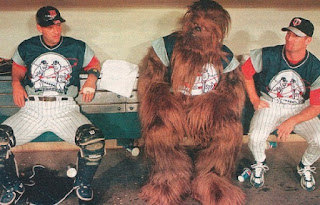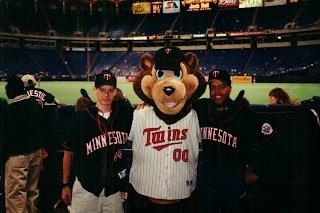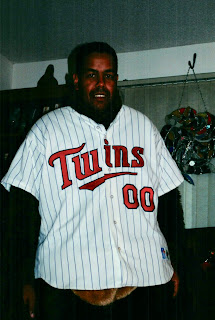In 1989 Paramount Pictures released to movie theaters across the land the film "Major League" as it opened on April 7th. It was a box office smash as it coincided with the opening of the major league baseball season. The movie told a fictional tale involving the Cleveland Indians over the course of a full season. The characters, to those of us old enough to remember, are as current today as they were back in summer of '89. Mention the names Jake Taylor, Roger Dorn, "Willie Mays" Hayes, Pedro Cerrano and Ricky "Wild Thing" Vaughn and you're bound to hear quotes from the film that have become part of the lexicon of baseball fans one the last three decades. The film cost $11 million to make and grossed just shy of $50 million at the box office. It spawned a sequel, Major League II in 1994. The latter took in some $30 million at the box office.
But we're not gonna talk about either of these movies.
We're gonna discuss the third cinematic masterpiece in the series. It was called Major League: Back To The Minors. Okay, cinematic masterpiece might not be the term one would use after investing 100 minutes to view it in its entirety. It was released on April 17, 1998, once again coinciding with the start of the real major league season. This time the Cleveland Indians weren't really even involved in the plot line. The major league foils for BTTM would be the Minnesota Twins. Interesting choice that they chose a franchise which had actually won their second world championship just 7 seasons earlier. When the first Major League film debuted the Indians hadn't been won a championship for 41 years. That was part of the charm of the film, in that it was a franchise that hadn't even made the postseason in 35 years. But things in the Twin Cities had taken a downward slide over the past few years. After they won the 1991 World Series the 5 previous seasons before the release of the film the Twins had finished in either 4th or 5th place and had averaged ending the season 24 games out of first place. Attendance had dropped by nearly half between '93 and '94 for four straight years. So they were easy to make fun of, I suppose.
How do I fit into this storyline? Well, In February of 1996 I became a member of the front office of the Minnesota Twins Baseball Club. It was a fantastic gig and I enjoyed it immensely during my time there. I was notified by a co-worker that the production company would be shooting scenes for the film at the Hubert H. Humphrey Metrodome for a couple of weeks. I inquired as to if I may be able to participate in some way. I received an email at the ballpark from Sonny, who was casting coordinator the extras for the Minneapolis unit.
Now, here's where I learned about how things work in the world of television and movie production. Sonny originally told me that I was actually going to appear as an extra on the Twins' bench. I thought that to be a fairly cool thing. But prior to the start of filming at the dome I learned that the only remaining uniforms they had were going to be too small for my 6'1" frame. And so I would need to be given something else to do. I was then offered a chance to be on the "second team". The "second team" would be the people who set-up the shots, set the proper lighting and such, before the actual actors step in and film the scene that makes the cut. So my acting career took an abrupt turn, but I still wanted to be involved. So the B-team would be my contribution. One of the actors whom I would "stand-in" for was an actor named Thom Barry who later would have a starring role in the CBS series "Cold Case"
The shooting schedule would begin at 8am each day, an hour before my normal shift at the ballpark normally would. But since the 1997 season had ended a few weeks earlier I was under not much pressure to be in my office throughout the day. My boss was gracious enough to let me participate on the film. Plus, my office wasn't all that far away, because even though I was on the field during shooting, a short walk up the four flights of stairs and a short right turn would have me at the door of my office.
Now, not all of the stars of the film were part of the Minneapolis shooting crew. Corbin Bernsen (Roger Dorn), Walton Goggins ("Downtown" Anderson) and Dennis Haysbert (Pedro Cerrano) were not with us, unfortunately. I was really hoping that Mr. Haysbert would have been with us as I wanted to see Jobu in person. But there were a couple of guys who were in the group whom I knew from their prior roles.
Eric Bruskotter, who also appeared in Major League II was in the group. Ted McGinley, who had just finished his 8th season on Married.......with Children was cast as the Twins' manager and Scott Bakula, who I had enjoyed watching on Quantum Leap, was cast as the manger of the Charleston Buzz.
The plot of the story is this: Roger Dorn is now the owner of the Minnesota Twins. Aging minor league pitcher Gus Cantrell, who plays for the Fort Myers Miracle, is planning to retire. Then, Roger recruits Gus to be the manager of the Buzz, the Twins' AAA minor league affiliate. Gus's mission is to make a real team out of a bunch of players who include ballet dancer turned ballplayer Lance "The Dance" Pere, minor league lifer Frank "Pops" Morgan, Rube Baker, Taka Tanaka, Pedro Cerrano, pitcher Hog Ellis, home run hitter Billy "Downtown" Anderson, and pitcher Carlton "Doc" Windgate, a medical school graduate who throws the slowest fastball in the minors.
However, Gus clashes with Leonard Huff, the snobby manager of the Twins. One night in Minnesota, Gus and his fiancee Maggie Reynolds are having dinner with Roger and Huff at an upscale restaurant, where Huff challenges Gus to a game between the Buzz and the Twins. Gus accepts the challenge.
The game is scheduled to take place at the Hubert H. Humphrey Metrodome in Minnesota. The Twins take a 3-0 lead in the 6th inning, but Downtown hits a home run that ties the game at 3-3 in the 8th inning. But with two outs in the bottom of the 9th inning, and with Doc one strike away from striking out home run hitter Carlos Liston, Huff has the stadium's lights turned off so the game can end with a tie rather than give the Buzz a chance to win in extra innings. However, the media reports that the Twins were still outplayed by the Buzz.
Huff now wants to bring Downtown up to the Twins, even though Gus believes that he is not yet ready. However, Anderson jumps on the opportunity, turning his back on Gus. Without Downtown, the Buzz start losing again. With the Twins, Anderson starts hitting poorly, proving Huff wrong. Gus manages to get the Buzz back on track, and Downtown is sent back down to the Buzz, where Gus teaches him how to be a more well rounded hitter. Gus leads the Buzz to a division title in their league.
Gus issues a challenge for Huff to bring the Twins to Buzz Stadium for another game. If the Twins win, Gus will give his salary for the year to Huff. If Gus and the Buzz beat the Twins, Gus can take over as the manager of the Twins. Huff accepts the challenge and takes the Twins to play against the Buzz. This time, the Twins take a 4-0 lead in the 6th inning, but the Buzz still manage to come from behind with three runs, and then win the game, 5-4, thanks to a game-winning two-run home run by Downtown. Gus decides that he wants to stay with the Buzz so he can continue to work with minor league players on their skills and hopefully turn them into stars.
One of the cool things that occurred during the filming was the scene where the lights go off in the dome. Now, I had worked as an usher's supervisor from 1989-1995. When it rained heavily we would sometimes have leaks in the roof. (Not making this up.). We moved our fair share of fans from seats where puddles would begin to form during rainstorms. But we'd never had the lights go out, at least not on purpose. The only problem with filming that scene was that it took what seemed like an eternity for the lights to get back to full strength so we could continue shooting.
Now, at the time the movie was being shot, the Twins' Triple-A affiliate was the Salt Lake Buzz. The uniforms were the same, but the team didn't actually play in Charleston, as the plot line said. Since they were a Twins affiliate I actually owned a number of Buzz-themed items. I had the cap, a jersey and a cool nylon hoodie. One afternoon when we were done filming for the day I was walking off the field while wearing the hoodie. One of the wardrobe ladies ran over to me and told me that I'd need to return the jacket to the wardrobe rack. I politely informed her that the Buzz indeed were an actual baseball team and that I was the owner of the jacket which I was wearing. Seems, some people involved in the film did not know that the Buzz was not a fictional team.
At the end of the filming I was given a choice. I could get paid for my time in a check from the production company or I could get on-screen credit which would make me a member of SAG (the Screen Actor's Guild). I took the money. In retrospect, I wish I'd made a different decision because I'd be able to see my name in the closing credits at the end of the film.
When the release date arrived my wife and I made our way to the local theatre which was showing it on one of their screens. Sure, it wasn't an epic by any stretch of the imagination. But it was a movie which I had actually worked on. There were a number of flaws in the production. A fairly glaring continuity issue on the scoreboard during the game played at the home field of the Buzz being on of them, which I noticed right away during our viewing. One odd thing was when showing Roger Dorn's private suite at the stadium there is a framed Twins jersey with the last name "Collins" and the number "4" on the back. This jersey only makes an impression on someone who saw an entirely different movie called "Little Big League" in which the Twins figure prominently on the plot line and was filmed in the Twin Cities. That movie was released in 1994.
I don't even recall the amount of money which I was paid for my efforts. It could not have been all that substantial. It was badly panned by critics, and deservedly so. Rotten Tomatoes gave it a 21% rating. It cost $18 million to make and grossed a whopping $3.5 million at the box office. The nice theatre manager let me come back and pick up the poster for the film after it had ended its run. I had it framed and it still resides in my man cave as a reminder that sequels are almost never as good as the original.
I'm just sayin'





















